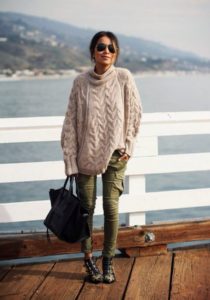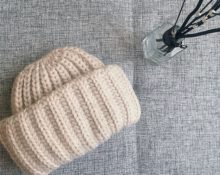The yarn market offers modern needlewomen a huge amount of material of different compositions and differing in their characteristics. Acrylic yarn is popular among both beginners and experienced craftswomen. Why is it good, read on.
What is acrylic yarn for knitting?
 Acrylic fibers were first obtained in 1947 from natural gas and are widely used in the textile industry. This is a synthetic substance that looks like a continuous thread. Products made from acrylic are similar to wool, which is why it was called “artificial wool”.
Acrylic fibers were first obtained in 1947 from natural gas and are widely used in the textile industry. This is a synthetic substance that looks like a continuous thread. Products made from acrylic are similar to wool, which is why it was called “artificial wool”.
Composition and properties of threads
Acrylic has many varieties, depending on the manufacturer, the following names may be found: PAN fiber, acrylan, dralon, kurtel, cashmilon, nitron, redon, prelon, krylor. When you see these names on the labels, you should remember that their chemical composition is identical. Threads are stronger than natural ones. Such the yarn is easy to work with and does not require a high level of skill - the loops do not get tangled, the threads are the same in thickness, suitable even for machine knitting.
What is a mixture of acrylic with another thread?
 For hand knitting, yarn with a composition of 100% acrylic is often used. To improve the properties of synthetic thread, natural fibers - wool or cotton - are added to it. In mixed compositions, acrylic can be present in a ratio of 5% or more. For example, adding mohair or wool will allow you to wear the product in the cold season and make the pile fluffier. Acrylic in combination with cotton will allow the skin to breathe and give the canvas hygroscopicity, these properties are usually lacking in artificial materials.
For hand knitting, yarn with a composition of 100% acrylic is often used. To improve the properties of synthetic thread, natural fibers - wool or cotton - are added to it. In mixed compositions, acrylic can be present in a ratio of 5% or more. For example, adding mohair or wool will allow you to wear the product in the cold season and make the pile fluffier. Acrylic in combination with cotton will allow the skin to breathe and give the canvas hygroscopicity, these properties are usually lacking in artificial materials.
Important! The yarn will have the properties of those threads that have a higher percentage in the composition.
Advantages and disadvantages
Why do knitting lovers value acrylic yarn? It has a number of properties that make it universal:
 the strength of the threads increases the service life of things and allows them to maintain their shape;
the strength of the threads increases the service life of things and allows them to maintain their shape;- not damaged by moths;
- low price, if children quickly outgrow knitted items, then making new ones will not cost much;
- does not cause allergic reactions, so it is recommended for children;
- acrylic item is pleasant to the skin - soft and warming;
- The thread has a permanent color - it does not fade or fade.
The disadvantages of acrylic yarn (we are talking about 100% acrylic) can be the following:
- low hygroscopicity and breathability, which limits the use of such material for products that are in close contact with the body;
- there is a risk of stretching when washing;
- with prolonged wear, pellets may appear;
- becomes electrified in dry air, giving an unpleasant “electric shock”.
What is knitted from acrylic?
 Thanks to its softness and lack of lint, acrylic yarn is considered the most suitable for knitting children's clothes. And it's not just clothing items or blankets. Amigurumi - knitted toys - are often made from this kind of thread. This allows them to be durable, keep their shape, and when dirty they can be easily washed and dried quickly.
Thanks to its softness and lack of lint, acrylic yarn is considered the most suitable for knitting children's clothes. And it's not just clothing items or blankets. Amigurumi - knitted toys - are often made from this kind of thread. This allows them to be durable, keep their shape, and when dirty they can be easily washed and dried quickly.
Women's accessories made of acrylic are quite widespread: handbags, slippers, gloves, leg warmers and much more, for which the author's imagination is enough. Interior items, such as: bedspreads and rugs for furniture, decorative pillowcases for sofa cushions, chair covers, rugs, napkins.
Important! To ensure that your favorite item made from acrylic yarn pleases your owner for as long as possible, you should remember about proper care.
Namely:
- You need to wash the product in the same way as wool - in water at room temperature (or no higher than 40 degrees);
- Machine washable on delicate cycle;
- squeeze through the fabric, do not twist;
- dry in a horizontal position on a flat surface;
- do not steam, iron with a warm iron using damp gauze.
Acrylic yarn has many positive qualities and allows you to realize any fantasies. If you remember the features of this material, then knitting and using finished products will bring a lot of pleasant moments.


 the strength of the threads increases the service life of things and allows them to maintain their shape;
the strength of the threads increases the service life of things and allows them to maintain their shape; 0
0





